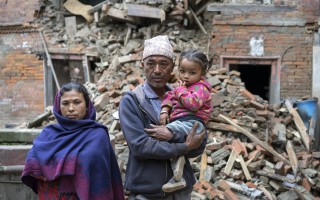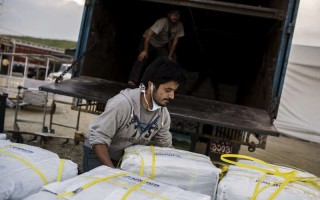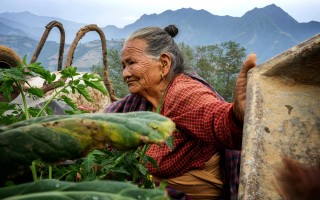One month ago, a devastating earthquake measuring 7.8 on the Richter scale destroyed the homes of more than 2.5 million Nepalis. Now begins a race to build temporary shelters before the heavy monsoon rains arrive in June. But rebuilding homes in the flattened rural districts, which continue to be hit by frequent aftershocks, also means finding ways to rebuild lives left in limbo.
Collapsed homes have buried farmers’ food supplies and tools, and crushed many of their buffaloes, goats and chickens. In many villages, it is mostly women, children and older men who will be in charge of rebuilding, as their fathers, sons or brothers work as migrant labourers in the Middle East, India and Malaysia. It is here, amid the rubble of countless towns and villages, that the new future of Nepal will take shape.
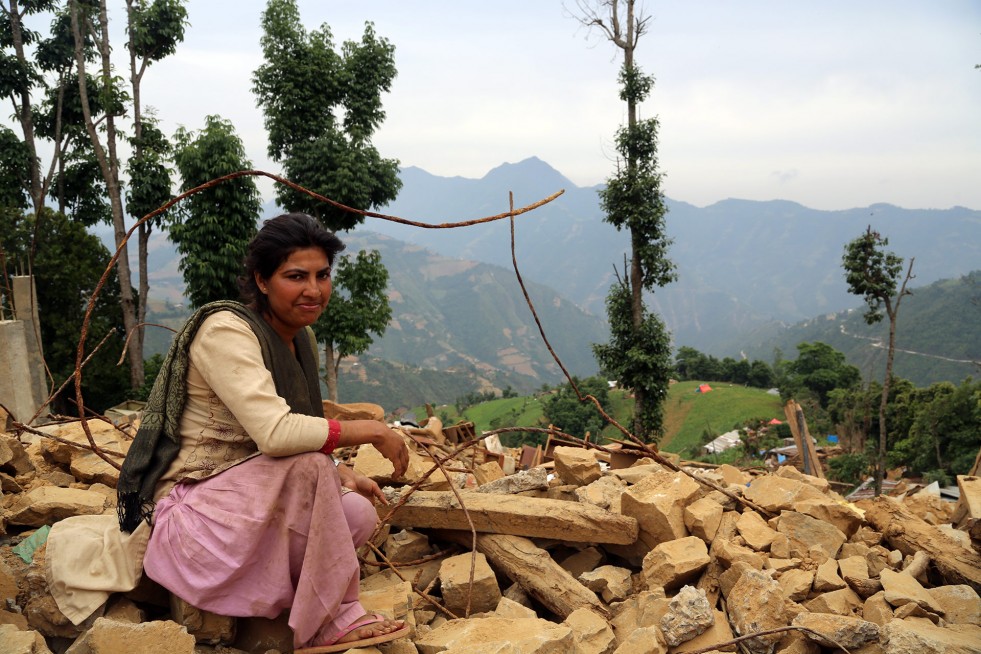
Prakiti Timalsena, 25, sits amid the ruins of her former home, which was the tallest house in Jhankridanda village. She is now living in one of the orange tents below. © UNHCR/Donatella Lorch
The Schoolteacher
Prakiti Timalsena, 25, grew up in the village of Jhankridanda, a small town of 3,000 inhabitants a three-hour drive into the mountains south of Kathmandu. Her family owned the largest house, built on a ledge right on the main road. On the ground floor, her mother had a cosmetics shop, and her uncle ran a grocery and a small hotel for travellers. A schoolteacher, Prakiti was studying for a Master’s degree in Nepali language in Patan, Kathmandu’s twin city. She says the quake shattered not only her home, but also all of her dreams. She has stopped attending school and moved back home to help rebuild. Her father died three years ago, and her brother has seasonal work in a rock quarry. Halfway through her story, she breaks into tears. Like so many in Nepal, she is still in shock.
“For the first five days, I could not move. I just sat here on the side of the road.”
“I cannot think anymore. Everything is gone and I must start from zero. My house is gone. My buffalo and nine goats are dead. I was in Patan when the quake hit. I grabbed a taxi, but he only took me to the Ring Road [less than a mile]. I waited there for hours until a neighbour came with a small truck to take me to my village [three hours away]. For the first five days, I could not move. I just sat here on the side of the road. On that second day after the first earthquake, it rained. We had no tarp, nothing. But all I could do was sit there and tell myself: “Why didn’t I think of buying a tarp in Patan, when the earthquake happened?” Now I am going to build a small stone house with just one floor. Yesterday a bulldozer came and moved some of the rubble. I found my documents, my citizenship card, my education certificates. But my mother lost her citizenship card. I did not even find a spoon or a pot.”
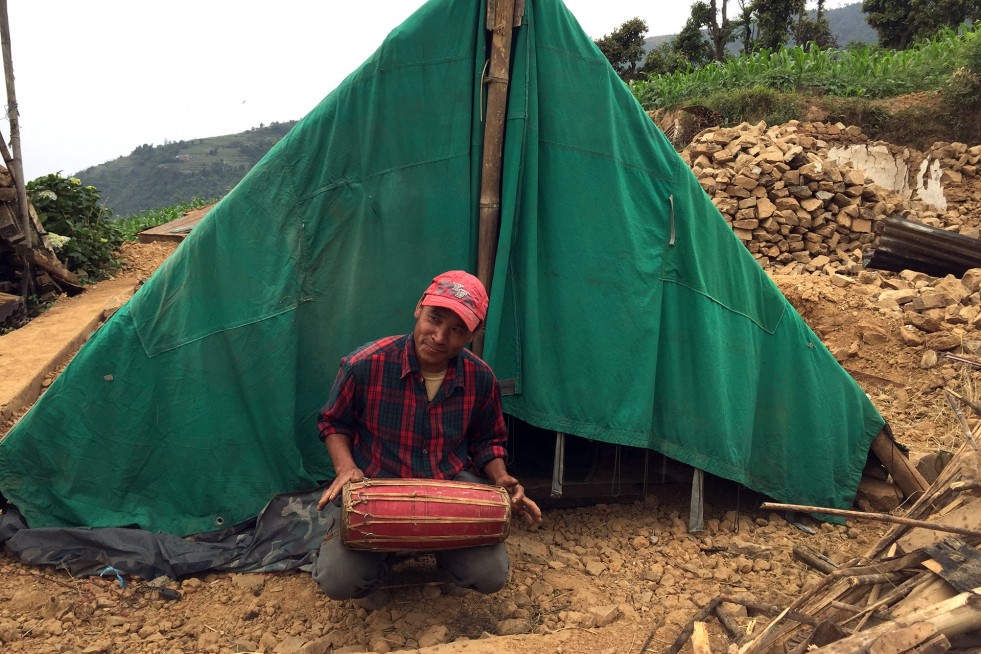
Jagat Thing, 42, lost his home but saved his family’s traditional drums. He entertains the village children with his playing, and his infectious laugh.
© UNHCR/Donatella Lorch
The Farmer
Jagat Thing, 42, is a short, wiry farmer with work-hardened hands and a laugh that inspires the village children to follow him around. When the earthquake hit, his family dashed out of the house and into the nearby cornfields. Jagat ran back into his crumbling home and pulled his elderly mother out by her legs. One of his two sons is a migrant worker in Malaysia. Since the quake Jagat has built two shelters: one for his animals and one for his family. A local NGO gave him a tent, and he managed to salvage the family’s traditional drums, which he plays to entertain the children. He keeps a live turtle in his corrugated iron home for good luck.
“We don’t have money to build right now, but if we work all together as a village, we can make it happen.”
“At first, right after the earthquake, I also just wanted to cry. But I cannot get anything back. What happened happened, and we cannot change that. Now it is time to rebuild. We don’t have money to build right now, but if we work all together as a village, we can make it happen. I am poor, I have a third-grade education, but I can read Nepali newspapers. My father was a construction worker and I learned many things from him. That is why I was able to quickly build this small room with the tin roof of my old home. But no more big houses. We villagers all agree on that. I tell all the children not to worry so much and I tell them the stories my grandfather told me about the big 1934 earthquake and all the aftershocks. It is important that the children eat on time and have good food. I tell them not to panic. I sing a song for them. I tell them that earthquakes come and go, but that does not mean that life stops.”
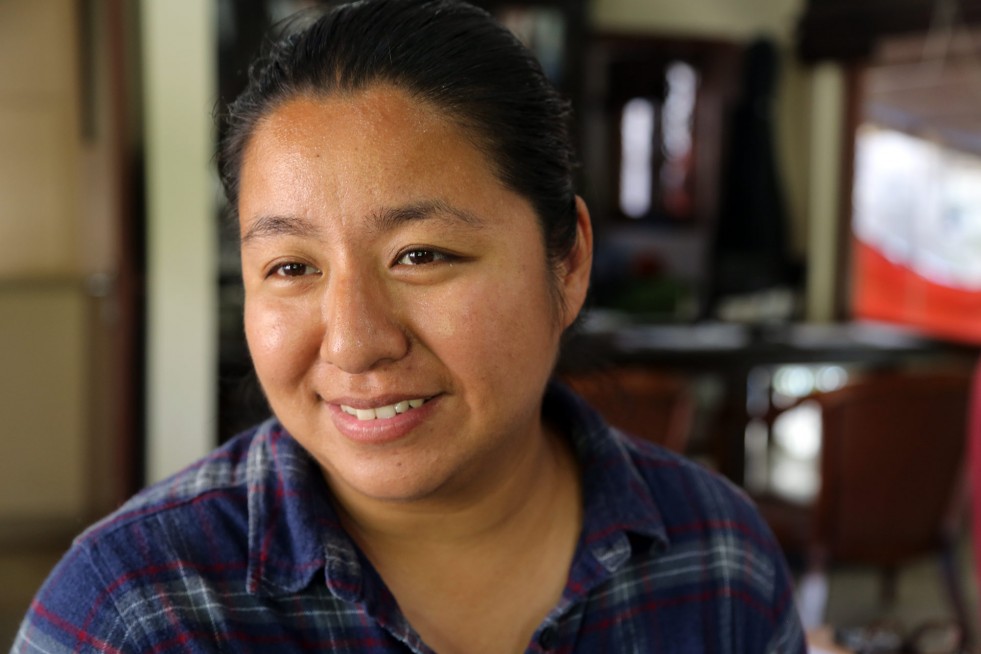
Nayantara Gurung Kakshapati, 33, sprung into action after the earthquake, forming a volunteer group that is bringing aid to remote villages.
© UNHCR/Donatella Lorch
The Activist
Nayantara Gurung Kakshapati, 33, is a professional photographer whose family runs a popular guest house in Patan, Kathmandu’s twin city. A few hours after the earthquake, several friends joined her at the Yellow House Bed & Breakfast and together they launched the Himalayan Disaster Relief Volunteer Group. As its unofficial head, Nayantara describes the group – better known in Nepal as Yellow House – as “an anarchic collective”. Through volunteer networks, as well as overseas Nepalis producing live maps of affected villages, it identifies the hardest-hit areas that have not received any assistance. Yellow House is part of a wider movement of Nepali volunteers who are helping tens of thousands of people affected by the earthquake. Carrying lists of village names, numbers of dead, injured and local needs, Yellow House volunteers drive and hike for days to reach ruined villages. UNHCR works with Yellow House, providing tarpaulins and solar lanterns to Nepal’s hardest-hit areas. Nayantara’s group is soon going to focus on reconstruction and other needs.
“For people to pick up their lives, they need a sense of dignity and agency.”
“Donations are slowing down now, and we now need to clear our heads and agree on what is most needed. Our group has a clear interest in working on longer-term shelters. I am personally interested in vocational training and skill building. For starters, basic construction skills can feed into income generation. For people to pick up their lives, they need a sense of dignity and agency. Already we are seeing the problem with just hand-outs. I don’t want people to sit around and wait for things to be sent to them. This is a collective; everyone brings their interests to the table. There is a clear interest in working with children, in education, in helping them cope with stress, anxiety, fear.”
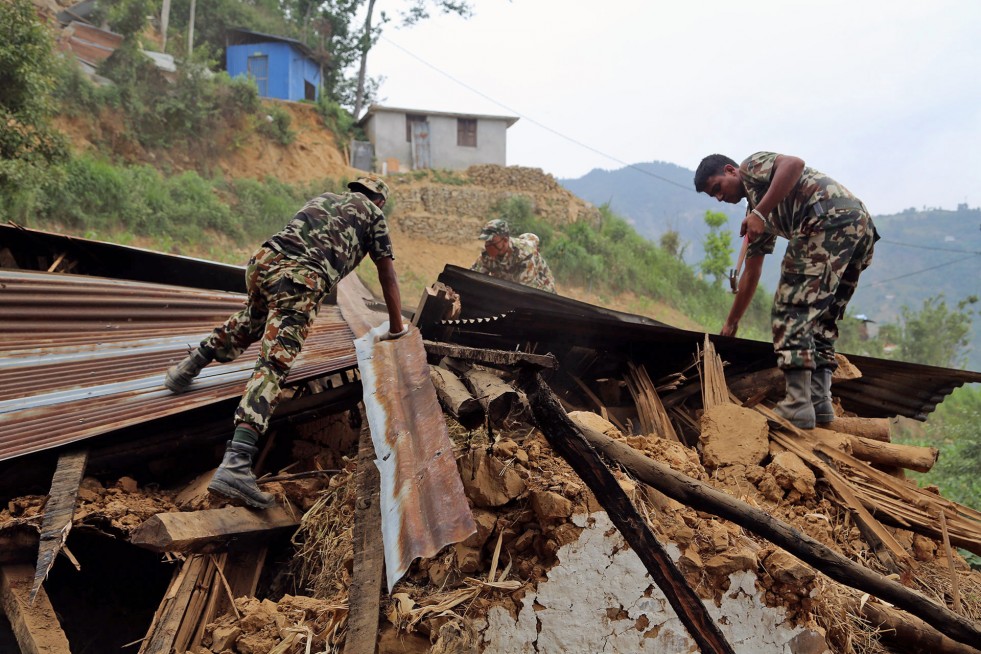
To prevent further injury, Nepali soldiers under the command of Quartermaster Sergeant Besh Bahadur Budhatoki dismantle an earthquake-damaged home in Jhankridanda. © UNHCR/Donatella Lorch
The Soldier
Quartermaster Sergeant Besh Bahadur Budhatoki, a 14-year veteran of the Nepali army, is the commanding officer of the soldiers providing security for a handful of villages including Jhankridanda, about three hours’ drive south of Kathmandu in the steep and rugged Himalayan foothills. He comes from Dholaka District, east of Kathmandu, which was hit hard by the first earthquake and then further shaken by the 7.3 magnitude aftershock on 12 May. He has not been home since early April. After the earthquake, his wife called to tell him that his house had been destroyed and that 16 family members were now homeless. He does not know when he will be allowed to leave his post and go help his family rebuild. From the very first day, the Nepali army and police have been at the forefront of relief operations, especially in the villages. Some units have been helicoptered into remote areas; others are deployed to clear roads buried by landslides, often with just shovels and their bare hands. In Jhankridanda, Sgt. Budhatoki’s men were working with long bamboo poles to bring down the remnants of a house’s walls. They also used thin rope to yank down wooden roof rafters. As the house collapsed in chunks, they were enveloped in clouds of dust and dirt. They carried salvaged sheets of corrugated iron roofing and piled them up neatly near a group of women and children whose house this had once been. Sgt. Budhatoki asked not to be photographed.
“So far in my life, this is the worst that I have ever witnessed.”
“The sole purpose of the Nepali Army is to serve the people. My men and I are usually based in the town of Lele [by 4X4 vehicle a two-hour drive north], but since the earthquake we have been here 24/7. So far in my life, this is the worst that I have ever witnessed. My men and I came in to do search-and-rescue and we managed to pull out some people that were still alive. But now we are the ones that tear down the houses and pull off the corrugated iron roofs. It is a dangerous job because the standing walls can collapse on top of people. One person cannot do this alone. The women cannot do this alone. Neither can the old men. We’ve helped people pull out food from under the rubble, and now we are going to try and raze the houses so that people can come back safely and select bricks and stones that they can use to rebuild.”
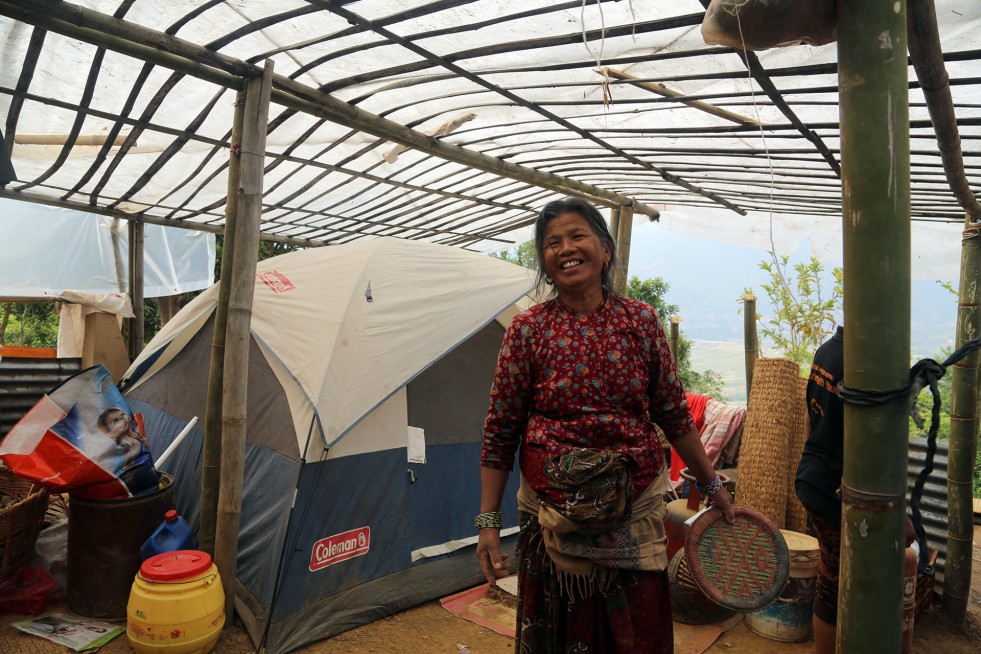
Kaili Thapa Magar, 60, misses her television. “I miss following the news around the world and I haven’t been able to see any of the destruction in other places in Nepal.”
©UNHCR/Donatella Lorch
The Grandmother
Kaili Thapa Magar says she was 11 when she got married and moved from the eastern district of Kavre to her husband’s home in the village of Kot Danda, straddling a ridge in the far southern side of the Kathmandu Valley. It takes 90 minutes by car to reach it from central Kathmandu, and the narrow dirt road can be treacherous during the monsoon season. Now 60 years old, she and her children and grandchildren had a comfortable concrete home with a television given to her by her youngest son, a migrant worker in Abu Dhabi. The earthquake flattened 90 per cent of the village, where houses were mostly made of traditional mud bricks. Kaili, who converted to Christianity at age 16, now lives in small tent donated by her local church, while the rest of the family lives and cooks under a tarpaulin held up by bamboo poles.
“We need to make Nepal a place where the poor and the rich have similar standards of houses that don’t fall with earthquakes.”
“I have never felt anything as horrible as this earthquake. I was so scared. And even now I am scared especially at night when I am not so busy and have time to think of what could happen. My main worry is that we don’t have a roof over our heads. Then I remember that I have not lost anyone in my family and that gives me happiness. Before, I used to take the animals to graze, now I dig in the rubble every day. I miss my TV. I miss following the news around the world and I haven’t been able to see any of the destruction in other places in Nepal. If we had good leaders, I am positive we can make this country a better place. We need to make Nepal a place where the poor and the rich have similar standards of houses that don’t fall with earthquakes.”
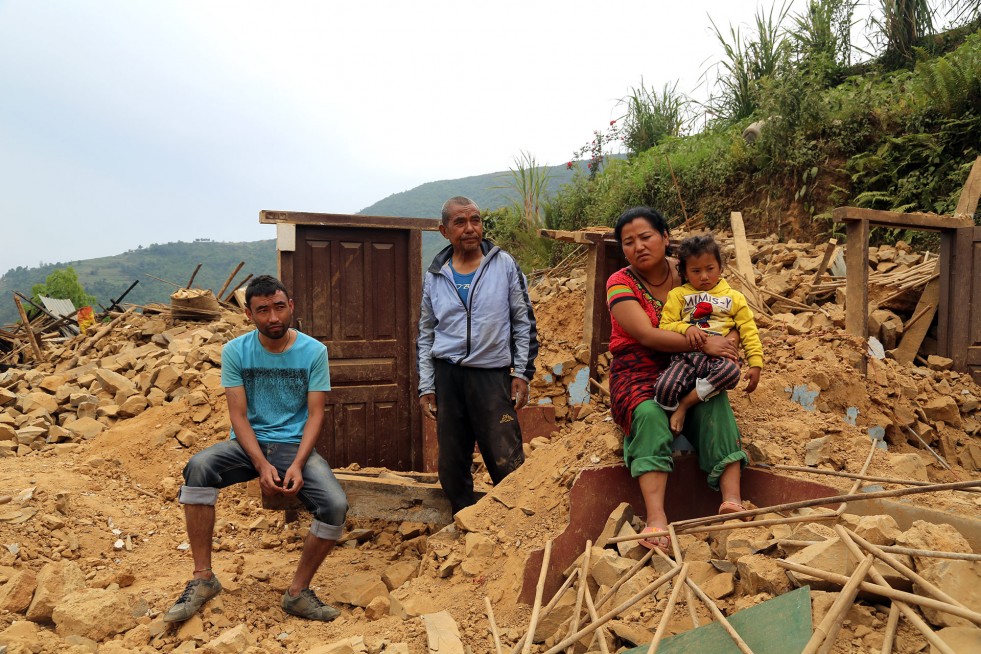
Raj Kumar Tamang (left) was working in Bahrain when the earthquake hit. He flew home to help his family – including his father, sister and nephew – pick up the pieces.
© UNHCR/Donatella Lorch
The Breadwinner
Raj Kumar Tamang, 28, was born in Jhankridanda, but like so many of Nepal’s young men he struggled to find work. Four years ago he went overseas and landed a job as a salesman in Bahrain, and began sending much of his earnings back home. After the earthquake, his employer gave him 15 days of emergency leave. He returned on 7 May, but where his family’s home once stood, he found a jumbled mass of bricks and stones. His older brother works in Saudi Arabia, but was not able to get leave from his employers. Raj Kumar is now responsible for 11 others, including his father, mother and his pregnant wife. He spends hours every day sitting on a wall and staring at his past.
“My father always tells me: ‘We are alive, that is what matters. We must think ahead, not behind.”
“We don’t have any money now, but I am responsible for my mother and father. My father keeps on telling me that I need to remember that we are all safe and that we have each other. But I am also very sad. You see that TV there in the rocks? I brought that home from Bahrain last year. I also bought everyone a mobile phone. They are now finished, buried in this dirt. My first baby will be born soon. Its life will be very hard. I don’t know how long it will take to make life return to what it was before. But my father always tells me: “We are alive, that is what matters. We must think ahead, not behind.”
Story By: Donatella Lorch



